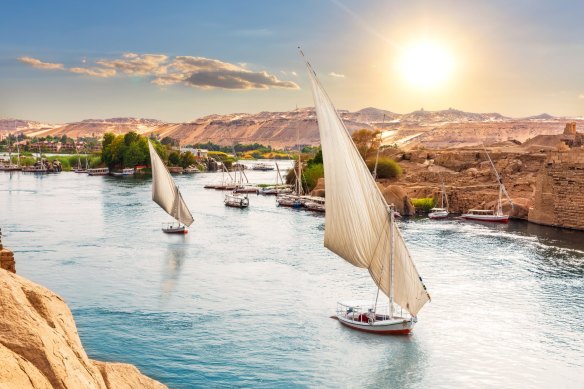Port guide: Aswan, Egypt
This ancient trading city on the Nile is the most wonderfully scenic of all Egypt’s riverside towns, with plenty of energy and attitude to match.
Who goes there
More than 250 river ships are licenced to sail on the Nile, where cruises typically run between Luxor and Aswan (or the reverse) on itineraries of between three and seven days. Cairo is almost always a land-based inclusion. AmaWaterways, APT, Avalon, CroisiEurope, Travelmarvel, Uniworld, Viking and luxury brands such as Abercrombie & Kent, Sanctuary, Sonesta and Oberoi are among ships operators.

On the Nile sailboats near the banks of Aswan, Egypt.Credit: Getty Images
Sail on in
Arriving in Aswan is a highly scenic finale to a highly scenic cruise. Aswan sits where the Nile narrows between islands, dramatic red hills, and the sweeping dunes of the desert. The river is dotted with grey granite boulders that have given one island its name, Elephantine. The new town rises in a flurry of noise and activity on the left; on the right you spot the ruins of the ancient town and the white cubist houses of a Nubian village.
Berth rites
Ships tie up along the Corniche on the east side of the Nile; the exact location depends on the company. Some may be a shuttle ride out of town, but upmarket lines dock in the middle of the city just south of Elephantine Island, near the Aswan Sporting Club. Don’t expect any facilities: you step off the ship straight into the city’s hubbub.
Going ashore
Aswan itself doesn’t have grand ancient ruins, but you’ll want to admire the glorious river setting from every angle, whether you’re strolling the Corniche, lush botanic gardens on Kitchener Island, or motley ruins and Nubian village of Elephantine Island. Afternoon tea on the verandah of the colonial-era Old Cataract hotel supplies one of the city’s best outlooks. Otherwise, the Nubia Museum displays quartz statues, ancient horse armour, jewellery and early Christian art. On the west bank, you can visit the ruined Monastery of St Simeon and mausoleum of Aga Khan III.
Don’t miss
The island of Philae, 10 kilometres upstream from Aswan on an artificial lake created by a dam. The Temple of Isis and another dedicated to Hathor might be Egypt’s most romantic ruins, their pillars matched by palm trees, their reflections shimmering in lake water where herons strut. The third-century-BCE temples have terrific reliefs showing gods and goddesses, mummification rituals and musicians. The evening sound-and-light show is excellent.
Get active
The riverside Corniche or promenade provides a long walk, although you’d best break into a jog to escape the attention of wannabe tour guides and souvenir touts. On the Nile’s western bank you could hike up the dunes in the cooler winter months. By far the most pleasant activity, however, is a sunset sail on a felucca to admire Aswan’s superb setting at its prettiest moment.
Retail therapy
Aswan, which has sat at a trading crossroads between Africa and the Mediterranean for thousands of years, has Egypt’s best souk outside Cairo. Inspect everything from textiles, jewellery and salted fish to spices such as saffron and dried hibiscus flower. Bedouin carpets, baskets, Nubian silver jewellery, cotton fabrics and tribal daggers and antiques are good buys.
Further afield
An excursion to Abu Simbel, a three-hour drive or 45-minute flight north into the desert, is usually included in cruise itineraries. Rightly so: this is one of the greatest sights in Egypt. The temple of Ramses II was relocated here following the building of the Aswan Dam. Three giant statues of the seated pharaoh brood on the facade, while inside you’ll find more statues and glorious reliefs.
Sign up for the Traveller Deals newsletter
Get exclusive travel deals delivered straight to your inbox. Sign up now.